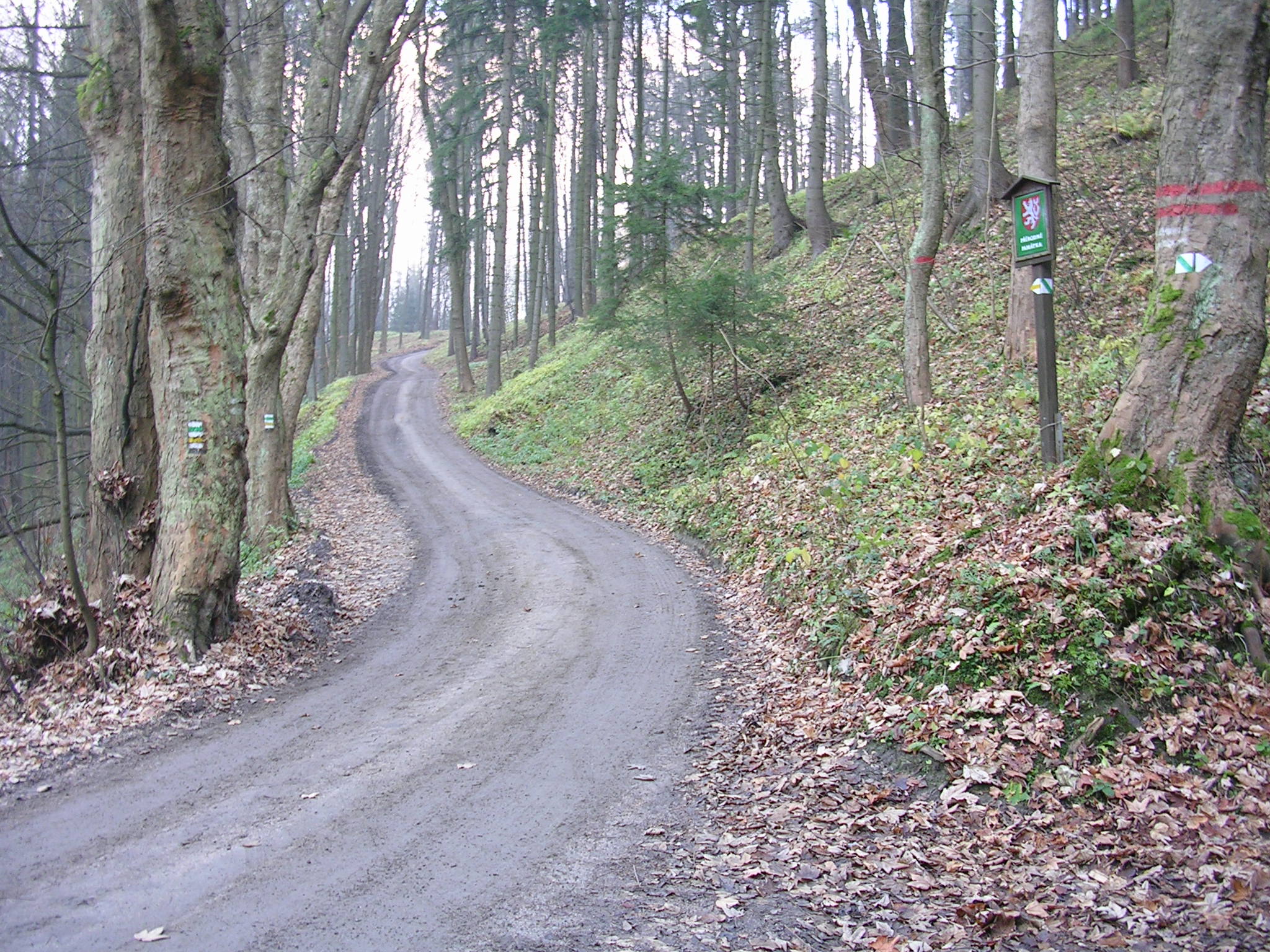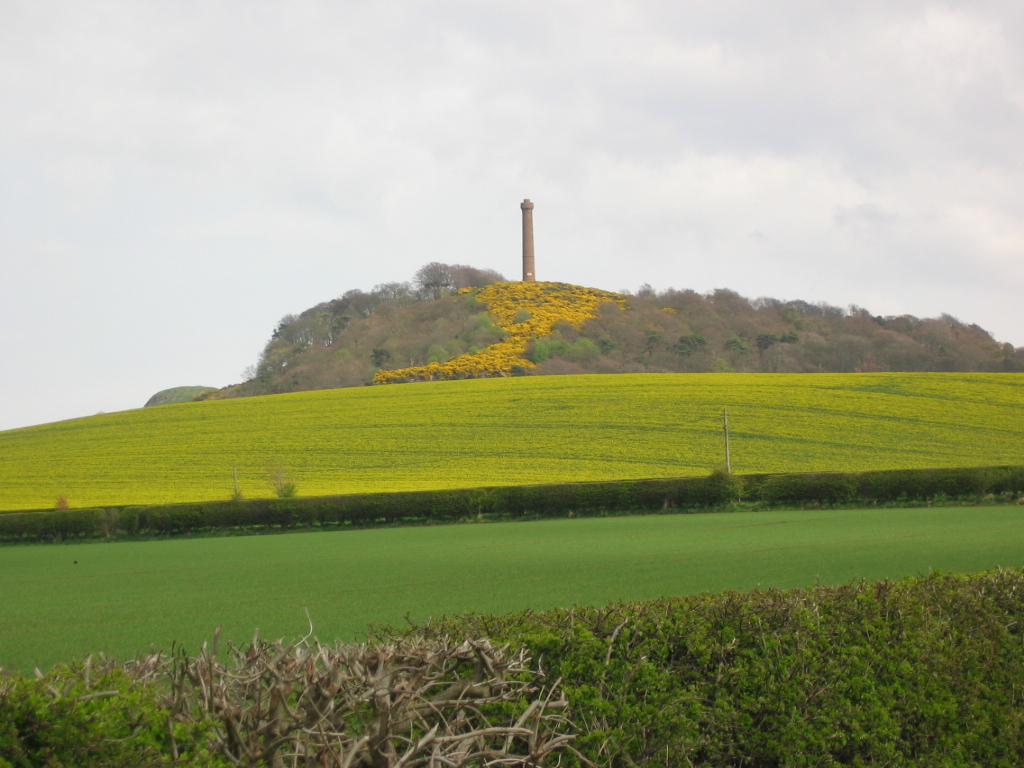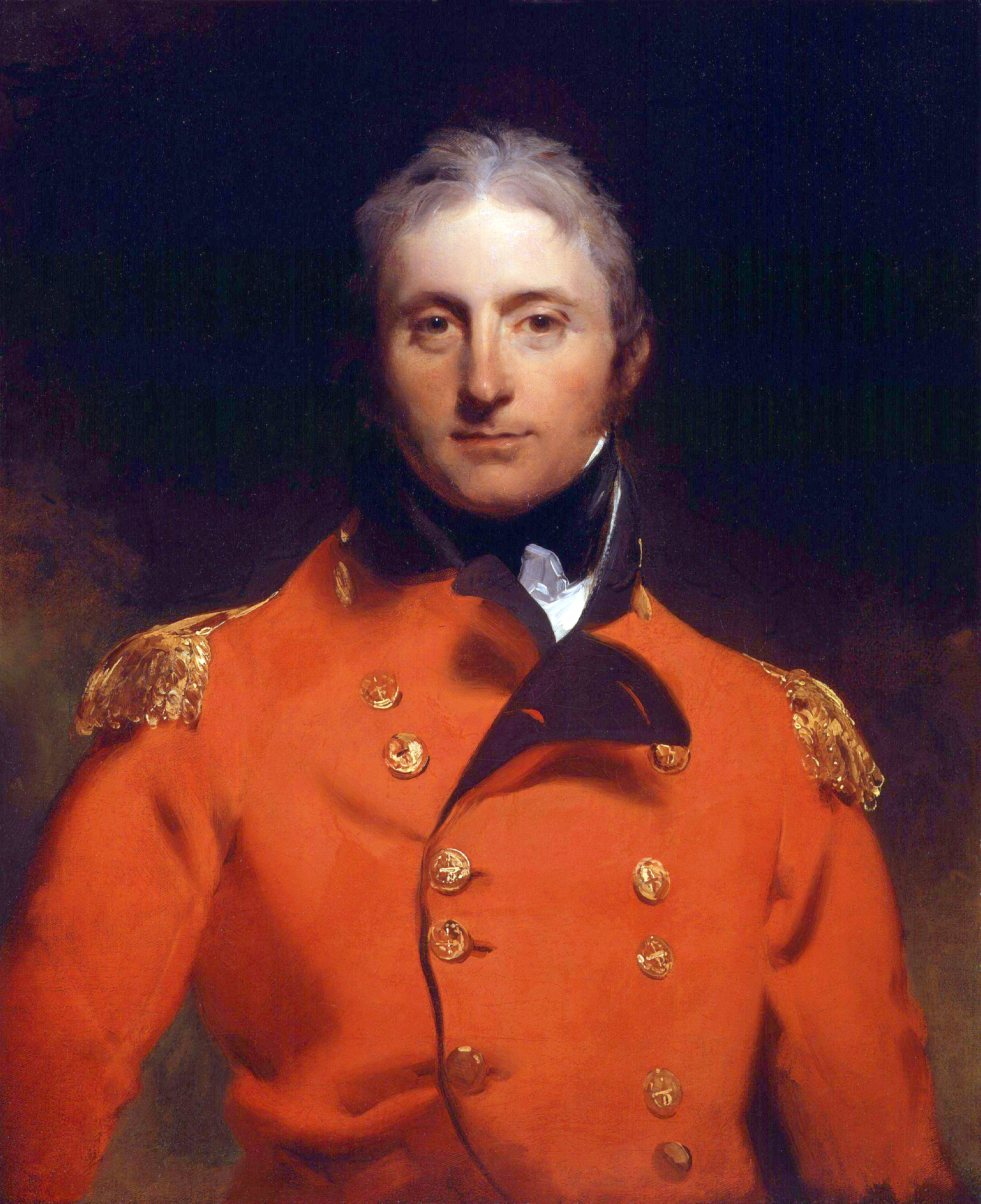|
Mount Hill
Mount Hill rises from the rolling farmland about three miles north west of Cupar in North East Fife, Scotland. On its summit stands the high Hopetoun Monument, which is visible for many miles around. The Hopetoun Monument was erected by the people of Cupar in 1826 in memory of the British soldier John Hope, 4th Earl of Hopetoun (1765–1823). The monument takes the form of a giant Roman Doric column, and is protected as a category B listed building. The inscription on the monument reads: Prior to succeeding to the earldom, John Hope served at the Battle of Alexandria in 1801 and, later, in the Peninsular War (1808–1814) where he was knighted for his heroic deeds at the Battle of Corunna. There is another similar Hopetoun Monument on Byres Hill near Haddington in East Lothian which was built in 1824. At present the summit of Mount Hill affords an excellent panorama due to the felling of the forestry plantation around the monument. The monument is easily accessible by ... [...More Info...] [...Related Items...] OR: [Wikipedia] [Google] [Baidu] |
Marilyn (hill)
This is a list of Marilyn hills and mountains in the United Kingdom, Isle of Man and Republic of Ireland, Ireland by height. Lists of mountains and hills in the British Isles#Marilyns, Marilyns are defined as peaks with a topographic prominence, prominence of or more, regardless of height or any other merit (e.g. topographic isolation, as used in Lists of mountains and hills in the British Isles#Munros, Munros). Thus, Marilyns can be mountains, with a height above , or relatively small hills. there were 2,011 recorded Marilyns. Definition The Marilyn classification was created by Alan Dawson in his 1992 book ''The Relative Hills of Britain''. The name Marilyn was coined by Dawson as a punning contrast to the ''Munro'' classification of Scottish mountains above , but which has no explicit prominence threshold, being homophonous with (Marilyn) ''Marilyn Monroe, Monroe''. The list of Marilyns was extended to Ireland by Clem Clements. Marilyn was the first of several subsequen ... [...More Info...] [...Related Items...] OR: [Wikipedia] [Google] [Baidu] |
Peninsular War
The Peninsular War (1807–1814) was the military conflict fought in the Iberian Peninsula by Spain, Portugal, and the United Kingdom against the invading and occupying forces of the First French Empire during the Napoleonic Wars. In Spain, it is considered to overlap with the Spanish War of Independence. The war started when the French and Spanish armies invaded and occupied Portugal in 1807 by transiting through Spain, and it escalated in 1808 after Napoleonic France occupied Spain, which had been its ally. Napoleon Bonaparte forced the abdications of Ferdinand VII and his father Charles IV and then installed his brother Joseph Bonaparte on the Spanish throne and promulgated the Bayonne Constitution. Most Spaniards rejected French rule and fought a bloody war to oust them. The war on the peninsula lasted until the Sixth Coalition defeated Napoleon in 1814, and is regarded as one of the first wars of national liberation. It is also significant for the emergence of larg ... [...More Info...] [...Related Items...] OR: [Wikipedia] [Google] [Baidu] |
David Lyndsay
Sir David Lyndsay of the Mount (c. 1490 – c. 1555; ''alias'' Lindsay) was a Scottish herald who gained the highest heraldic office of Lyon King of Arms. He remains a well regarded poet whose works reflect the spirit of the Renaissance, specifically as a makar. Biography He was the son of David Lyndsay, second of the Mount (Fife), and of Garmylton, (Haddingtonshire) (d.''circa.'' 1503). His place of birth and early education are unknown, but he may have attended the University of St Andrews, on the books of which appears an entry "Da Lindesay" for the session 1508–1509. He was engaged as a courtier in the Royal Household; first as an equerry, then as an usher (assistant to a head-tutor) to the future King James V of Scotland. His poems mention that he was involved in the education of James V and some contain advice for the young king. In 1522 he married Janet Douglas, a court seamstress. His first heraldic appointment was as Snowdon Herald and in 1529 he was appoint ... [...More Info...] [...Related Items...] OR: [Wikipedia] [Google] [Baidu] |
Forest Track
Forest tracks or forest roads are roads or tracks intended to carry motorised vehicles or horse-drawn wagons being used mainly or exclusively for forestry purposes, such as conservation or logging. Forest tracks may be open to ramblers or mountain bikers depending on local rules. Description Forest roads may be tarmacked, gravelled or metalled (using hard core) and often have restrictions on use. In many regions the establishment of forest roads is not only subject to approval under forest management law, but also conservation law. in Tyrol retrieved 28 June 2010 In and other especially important conservation areas, forest roads and tracks are generally si ... [...More Info...] [...Related Items...] OR: [Wikipedia] [Google] [Baidu] |
Forestry Plantation
A tree plantation, forest plantation, plantation forest, timber plantation or tree farm is a forest planted for high volume production of wood, usually by planting one type of tree as a monoculture forest. The term ''tree farm'' also is used to refer to tree nurseries and Christmas tree farms. Plantation forestry can produce a high volume of wood in a short period of time. Plantations are grown by state forestry authorities (for example, the Forestry Commission in Britain) and/or the paper and wood industries and other private landowners (such as Weyerhaeuser, Rayonier and Sierra Pacific Industries in the United States or Asia Pulp & Paper in Indonesia). Christmas trees are often grown on plantations, and in southern and southeastern Asia, teak plantations have recently replaced the natural forest. Industrial plantations are actively managed for the commercial production of forest products. Industrial plantations are usually large-scale. Individual blocks are usually even-aged ... [...More Info...] [...Related Items...] OR: [Wikipedia] [Google] [Baidu] |
East Lothian
East Lothian (; sco, East Lowden; gd, Lodainn an Ear) is one of the 32 council areas of Scotland, as well as a historic county, registration county and lieutenancy area. The county was called Haddingtonshire until 1921. In 1975, the historic county was incorporated for local government purposes into Lothian Region as East Lothian District, with some slight alterations of its boundaries. The Local Government etc. (Scotland) Act 1994 later created East Lothian as one of 32 modern council areas. East Lothian lies south of the Firth of Forth in the eastern central Lowlands of Scotland. It borders Edinburgh to the west, Midlothian to the south-west and the Scottish Borders to the south. Its administrative centre and former county town is Haddington while the largest town is Musselburgh. Haddingtonshire has ancient origins and is named in a charter of 1139 as ''Hadintunschira'' and in another of 1141 as ''Hadintunshire''. Three of the county's towns were designated as roy ... [...More Info...] [...Related Items...] OR: [Wikipedia] [Google] [Baidu] |
Haddington, East Lothian
The Royal Burgh of Haddington ( sco, Haidintoun, gd, Baile Adainn) is a town in East Lothian, Scotland. It is the main administrative, cultural and geographical centre for East Lothian. It lies about east of Edinburgh. The name Haddington is Anglo-Saxon, dating from the sixth or seventh century AD when the area was incorporated into the kingdom of Bernicia. The town, like the rest of the Lothian region, was ceded by King Edgar of England and became part of Scotland in the tenth century. Haddington received Burgh status, one of the earliest to do so, during the reign of David I (1124–1153), giving it trading rights which encouraged its growth into a market town. Today, Haddington is a small town with a population of fewer than 10,000 people. But during the High Middle Ages it was the fourth-biggest town in Scotland (after Aberdeen, Roxburgh and Edinburgh). In the middle of the town is the Haddington Town House, completed in 1745 based on a plan by William Adam. When firs ... [...More Info...] [...Related Items...] OR: [Wikipedia] [Google] [Baidu] |
Hopetoun Monument
The Hopetoun Monument is a monument in the Garleton Hills, near Camptoun, East Lothian, Scotland. It is tall and is situated on Byres Hill near Haddington. History The monument was erected in 1824 in memory of John Hope, 4th Earl of Hopetoun (1765–1823). The foundation stone was laid on May 3, 1824. There is an inscription on the monument which states: The monument is often referred to as the Garleton Monument or the "Galla Monument" by locals, after Garleton Farm on Byres Hill. Features The viewing platform at the top is reached by 132 steps of a dark, narrow, spiral staircase, and offers views of the Firth of Forth and the surrounding countryside. The monument is a category B listed building. A path runs from a small car park at the base of the hill, winding up steeply through wooded slopes, and a corridor of gorse, before coming out onto the open hilltop. The views can be superb: The Firth of Forth and Fife; Edinburgh and the Pentland Hills to the west; and The La ... [...More Info...] [...Related Items...] OR: [Wikipedia] [Google] [Baidu] |
Battle Of Corunna
The Battle of Corunna (or ''A Coruña'', ''La Corunna'', ''La Coruña'' or ''La Corogne''), in Spain known as Battle of Elviña, took place on 16 January 1809, when a French corps under Marshal of the Empire Jean de Dieu Soult attacked a British army under Lieutenant-General Sir John Moore. The battle took place amidst the Peninsular War, which was a part of the wider Napoleonic Wars. It was a result of a French campaign, led by Napoleon, which had defeated the Spanish armies and caused the British army to withdraw to the coast following an unsuccessful attempt by Moore to attack Soult's corps and divert the French army. Doggedly pursued by the French under Soult, the British made a retreat across northern Spain while their rearguard fought off repeated French attacks. Both armies suffered extremely from the harsh winter conditions. Much of the British army, excluding the elite Light Brigade under Robert Craufurd, suffered from a loss of order and discipline during the retrea ... [...More Info...] [...Related Items...] OR: [Wikipedia] [Google] [Baidu] |
Battle Of Alexandria (1801)
The Battle of Alexandria, or Battle of Canope, was fought on 21 March 1801 between the army of Napoleon's French First Republic under General Jacques-François Menou and the British expeditionary corps under Sir Ralph Abercromby. The battle took place near the ruins of Nicopolis, on the narrow spit of land between the sea and Lake Abukir, along which the British troops had advanced towards Alexandria after the actions of Abukir on 8 March and Mandora on 13 March. The fighting was part of the French campaign in Egypt and Syria against the Ottoman Empire, which began in 1798. Prelude Following Lanusse's reverse at Mandora, Menou finally arrived from Cairo to take direct command of French forces, and determined to attack on 21st March. François Lanusse would lead on the left with the brigades of Valentin and Silly, supported by the infantry Divisions of Antoine-Guillaume Rampon in the centre and Jean Reynier on the right. The British position on the night of 20 March extende ... [...More Info...] [...Related Items...] OR: [Wikipedia] [Google] [Baidu] |
Fife
Fife (, ; gd, Fìobha, ; sco, Fife) is a council area, historic county, registration county and lieutenancy area of Scotland. It is situated between the Firth of Tay and the Firth of Forth, with inland boundaries with Perth and Kinross (i.e. the historic counties of Perthshire and Kinross-shire) and Clackmannanshire. By custom it is widely held to have been one of the major Pictish kingdoms, known as ''Fib'', and is still commonly known as the Kingdom of Fife within Scotland. A person from Fife is known as a ''Fifer''. In older documents the county was very occasionally known by the anglicisation Fifeshire. Fife is Scotland's third largest local authority area by population. It has a resident population of just under 367,000, over a third of whom live in the three principal towns, Dunfermline, Kirkcaldy and Glenrothes. The historic town of St Andrews is located on the northeast coast of Fife. It is well known for the University of St Andrews, the most ancient univers ... [...More Info...] [...Related Items...] OR: [Wikipedia] [Google] [Baidu] |
Listed Building
In the United Kingdom, a listed building or listed structure is one that has been placed on one of the four statutory lists maintained by Historic England in England, Historic Environment Scotland in Scotland, in Wales, and the Northern Ireland Environment Agency in Northern Ireland. The term has also been used in the Republic of Ireland, where buildings are protected under the Planning and Development Act 2000. The statutory term in Ireland is " protected structure". A listed building may not be demolished, extended, or altered without special permission from the local planning authority, which typically consults the relevant central government agency, particularly for significant alterations to the more notable listed buildings. In England and Wales, a national amenity society must be notified of any work to a listed building which involves any element of demolition. Exemption from secular listed building control is provided for some buildings in current use for worship, ... [...More Info...] [...Related Items...] OR: [Wikipedia] [Google] [Baidu] |








